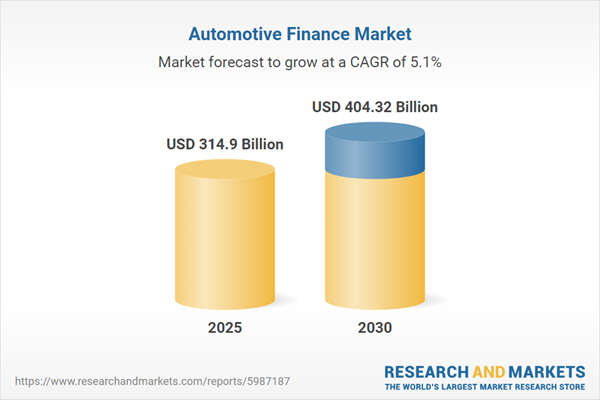The Automotive Finance Market, valued at US$404.32 billion in 2030 from US$314.896 billion in 2025, is projected to grow at a CAGR of 5.13% through 2030.
Automotive finance, or auto finance, is a type of financial service that is offered by banks, OEMs, and other financial institutions to consumers for the purchase of automobiles.
The major factor propelling the growth of the global automotive finance market is the increasing global demand for automobiles. The growing digital transformation in the financial sector is also estimated to boost the market during the estimated timeline.
Some of the major players covered in this report include Tata Motors Finance, Genpact, Solifi, Bajaj Auto Finance, Muthoot FinCorp, Sopra Banking Software, SAIC Motor, Wells Fargo, Lincoln, Mahindra Finance, Ford Motor Company, Ally Financial Inc., Laxmi India Finance Limited, Toyota Financial Services, and Volkswagen Financial Services among others:
Automotive finance, or auto finance, is a type of financial service that is offered by banks, OEMs, and other financial institutions to consumers for the purchase of automobiles.
The major factor propelling the growth of the global automotive finance market is the increasing global demand for automobiles. The growing digital transformation in the financial sector is also estimated to boost the market during the estimated timeline.
Market Trends:
- The automotive financial services market is witnessing significant growth, driven by the increasing availability of flexible financing options and advancements in financial technology. These developments have enhanced consumer convenience, enabling individuals to access tailored finance solutions from a wide range of providers with greater ease. This trend is particularly impactful in the automotive sector, where affordability and accessibility of financing play a critical role in purchasing decisions.
- A key factor propelling the growth of this market is the rising global demand for automobiles. As vehicle ownership continues to expand worldwide, there is a corresponding increase in the need for affordable and convenient financial solutions. This demand is further amplified by evolving consumer preferences and the growing adoption of vehicles in both developed and emerging markets.
- In North America, the automotive financial services market is benefiting from positive economic trends, including rising GDP and improved living standards. Higher disposable incomes have spurred demand for major durable goods, such as vehicles, significantly boosting sales volumes. For instance, according to the International Organization of Motor Vehicle Manufacturers (OICA), automotive sales in the United States reached 16 million units in 2023, reflecting a 12.5% increase compared to 2022. This growth underscores the region's strong economic momentum and its impact on the automotive sector.
Some of the major players covered in this report include Tata Motors Finance, Genpact, Solifi, Bajaj Auto Finance, Muthoot FinCorp, Sopra Banking Software, SAIC Motor, Wells Fargo, Lincoln, Mahindra Finance, Ford Motor Company, Ally Financial Inc., Laxmi India Finance Limited, Toyota Financial Services, and Volkswagen Financial Services among others:
Key Benefits of this Report:
- Insightful Analysis: Gain detailed market insights covering major as well as emerging geographical regions, focusing on customer segments, government policies and socio-economic factors, consumer preferences, industry verticals, and other sub-segments.
- Competitive Landscape: Understand the strategic maneuvers employed by key players globally to understand possible market penetration with the correct strategy.
- Market Drivers & Future Trends: Explore the dynamic factors and pivotal market trends and how they will shape future market developments.
- Actionable Recommendations: Utilize the insights to exercise strategic decisions to uncover new business streams and revenues in a dynamic environment.
- Caters to a Wide Audience: Beneficial and cost-effective for startups, research institutions, consultants, SMEs, and large enterprises.
What can businesses use this report for?
Industry and Market Insights, Opportunity Assessment, Product Demand Forecasting, Market Entry Strategy, Geographical Expansion, Capital Investment Decisions, Regulatory Framework & Implications, New Product Development, Competitive Intelligence.Report Coverage:
- Historical data from 2022 to 2024 & forecast data from 2025 to 2030
- Growth Opportunities, Challenges, Supply Chain Outlook, Regulatory Framework, and Trend Analysis
- Competitive Positioning, Strategies, and Market Share Analysis
- Revenue Growth and Forecast Assessment of segments and regions including countries
- Company Profiling (Strategies, Products, Financial Information, and Key Developments among others)
Automotive Finance Market is analyzed into the following segments:
By Type
- Direct Financing
- Indirect Financing
By Provider Type
- Bank
- OEMs
- Others
By Purpose Type
- Loan
- Lease
By Vehicle Type
- Passenger Cars
- Commercial Vehicles
By Geography
- North America
- USA
- Canada
- Mexico
- South America
- Brazil
- Argentina
- Others
- Europe
- Germany
- UK
- France
- Spain
- Others
- Middle East and Africa
- UAE
- Israel
- Others
- Asia Pacific
- China
- Japan
- South Korea
- India
- Indonesia
- Taiwan
- Thailand
- Others
Table of Contents
1. EXECUTIVE SUMMARY4. TECHNOLOGICAL OUTLOOK
2. MARKET SNAPSHOT
3. BUSINESS LANDSCAPE
5. AUTOMOTIVE FINANCE MARKET BY TYPE
6. AUTOMOTIVE FINANCE MARKET BY PROVIDER TYPE
7. AUTOMOTIVE FINANCE MARKET BY PURPOSE TYPE
8. AUTOMOTIVE FINANCE MARKET BY VEHICLE TYPE
9. AUTOMOTIVE FINANCE MARKET BY GEOGRAPHY
10. COMPETITIVE ENVIRONMENT AND ANALYSIS
11. COMPANY PROFILES
12. APPENDIX
Companies Mentioned
- Tata Motors Finance
- Genpact
- Solifi
- Bajaj Auto Finance
- Muthoot FinCorp
- Sopra Banking Software
- SAIC Motor
- Wells Fargo
- Lincoln
- Mahindra Finance
- Ford Motor Company
- Ally Financial Inc.
- Laxmi India Finance Limited
- Toyota Financial Services
- Volkswagen Financial Services
Methodology

LOADING...
Table Information
| Report Attribute | Details |
|---|---|
| No. of Pages | 140 |
| Published | February 2025 |
| Forecast Period | 2025 - 2030 |
| Estimated Market Value ( USD | $ 314.9 Billion |
| Forecasted Market Value ( USD | $ 404.32 Billion |
| Compound Annual Growth Rate | 5.1% |
| Regions Covered | Global |
| No. of Companies Mentioned | 15 |









